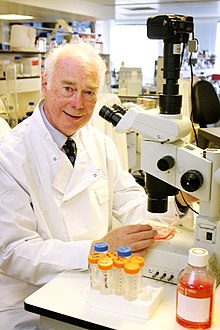Sir Martin Evans | |
|---|---|
 Evans in October 2007 | |
| Born | Martin John Evans 1 January 1941 Stroud, Gloucestershire, England |
| Education |
|
| Known for | Discovering embryonic stem cells, and development of the knockout mouse and gene targeting. |
| Spouse |
Judith Clare Williams MBE
(m. 1966) |
| Children | Two sons and one daughter[1] |
| Awards |
|
| Scientific career | |
| Fields | Developmental biology |
| Institutions | |
| Thesis | Studies on the ribonucleic acid of early amphibian embryos |
| Doctoral students | Allan Bradley[2][3] Elizabeth Robertson |
| Website | cardiff |
Sir Martin John Evans FRS FMedSci FLSW (born 1 January 1941) is an English biologist[5] who, with Matthew Kaufman, was the first to culture mice embryonic stem cells and cultivate them in a laboratory in 1981. He is also known, along with Mario Capecchi and Oliver Smithies, for his work in the development of the knockout mouse and the related technology of gene targeting, a method of using embryonic stem cells to create specific gene modifications in mice.[6][7] In 2007, the three shared the Nobel Prize in Physiology or Medicine in recognition of their discovery and contribution to the efforts to develop new treatments for illnesses in humans.[8][9][10][11][12]
He won a major scholarship to Christ's College, Cambridge at a time when advances in genetics were occurring there and became interested in biology and biochemistry.[citation needed] He then went to University College London where he learned laboratory skills supervised by Elizabeth Deuchar. In 1978, he moved to the Department of Genetics, at the University of Cambridge, and in 1980 began his collaboration with Matthew Kaufman. They explored the method of using blastocysts for the isolation of embryonic stem cells. After Kaufman left, Evans continued his work, upgrading his laboratory skills to the newest technologies, isolated the embryonic stem cell of the early mouse embryo and established it in a cell culture. He genetically modified and implanted it into adult female mice with the intent of creating genetically modified offspring, work for which he was awarded the Nobel Prize in 2007. In 2015, he was elected a Fellow of the Learned Society of Wales.[13] Today, genetically modified mice are considered vital for medical research.
- ^ a b c Cite error: The named reference
evanswhowas invoked but never defined (see the help page). - ^ Bradley, Allan (1985). Isolation characterization and developmental potential of murine embryo-derived stem cells (PhD thesis). University of Cambridge.
- ^ "Allan Bradley - Wellcome Trust Sanger Institute". Sanger.ac.uk. Archived from the original on 13 November 2013.
- ^ "Martin Evans". Desert Island Discs. 17 February 2008. BBC Radio 4. Retrieved 18 January 2014.
- ^ "Christ College Cambridge Alumni".
- ^ Stem cell architect is knighted BBC News : Wednesday, 31 December 2003
- ^ Evans, Martin J. (October 2001). "The cultural mouse". Nature Medicine. 7 (10): 1081–1083. doi:10.1038/nm1001-1081. PMID 11590418. S2CID 26951331. (subscription required)
- ^ "The Nobel Prize in Physiology or Medicine 2007". Nobelprize.org. Retrieved 8 October 2007.
- ^ "Desert Island Discs with Martin Evans". Desert Island Discs. 17 February 2008. BBC. Radio 4.
- ^ "Professor Sir Martin Evans Nobel Prize for Medicine". Cardiff University. Archived from the original on 26 January 2013.
- ^ Cite error: The named reference
Nobelprizewas invoked but never defined (see the help page). - ^ "A celebration of science in the UK: 10 Britons who shaped our world". The Independent. 5 July 2006.
- ^ Wales, The Learned Society of. "Martin Evans". The Learned Society of Wales. Retrieved 30 August 2023.